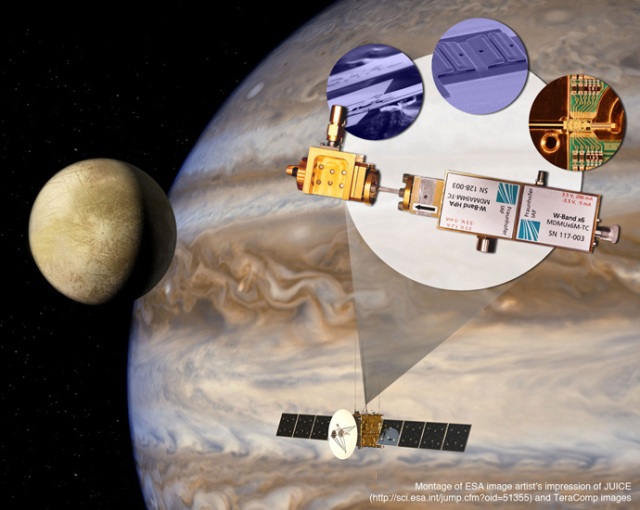Oct 9 2013
A high performance terahertz receiver aiming for space missions such as ESA’s “Jupiter icy moons explorer” has been developed in a joint European effort, led by Chalmers University of Technology.
 An illustration of the receiver in JUICE (Jupiter Icy Moons Explorer), which will make detailed observations of Jupiter and its moons. Image: ESA and Chalmers
An illustration of the receiver in JUICE (Jupiter Icy Moons Explorer), which will make detailed observations of Jupiter and its moons. Image: ESA and Chalmers
Remote analysis of gases and vapours by heterodyne spectroscopy is a powerful tool in environmental monitoring, astronomy, and planetary research. Particularly for space applications, compact, light-weight and robust heterodyne spectrometers are necessary.
In a joint European effort, researchers have developed a heterodyne receiver which satisfies the requirements set by space missions. This is achieved by minimising the number of components in the local oscillator (LO) of the receiver, and by a high degree of integration of all of its subcomponents.
“The unique sensor is compact, light-weight, robust and operates at room temperature, a necessity for satellite missions requiring many years of operation”, says project leader Jan Stake, professor at Chalmers University of Technology.
The receiver is optimised for the frequency band from 520 to 590 GHz. In this range, water vapour and a number of other important atmospheric trace gases, have significant spectral lines.
The researchers have achieved record performance in terms of sensitivity (noise).The key to this result is the high performance semiconductor devices used, and within the project a complete in-house membrane integrated Schottky diode process, suitable for terahertz applications, has been developed at Chalmers.
“The results demonstrate that the receiver is very well suited for remote sensing of atmospheres and astronomical objects”, says Jan Stake. “Due to its small mass and input power, the receiver is particularly suited for planetary missions such as ESA’s JUICE (Jupiter Icy Moons Explorer) mission.”
The receiver is a direct result of a project called TeraComp, a collaboration between European universities, institutes and industry, funded by the European Commission.
Within the project, Omnisys Instruments, producer of high performance electronics for space science applications, was responsible for design of mixer and the integration of the final receiver.
“Thanks to the collaboration and results generated within the TeraComp project, Omnisys has further strengthened its position in terahertz receiver technology”, says Martin Kores, CEO of Omnisys. “We are now selected as a partner and supplier of the 557-GHz channel in the Industrial Consortium for SWI, which is the submillimetre wave instrument for the JUICE mission.”